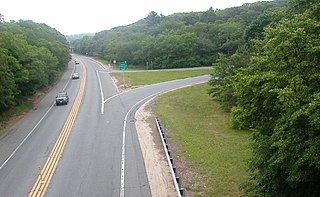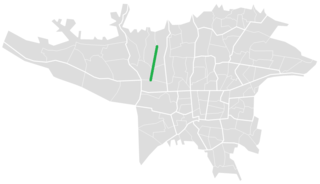
Tehran province is one of the 31 provinces of Iran. Its capital is the city of Tehran.

A limited-access road, known by various terms worldwide, including limited-access highway, dual-carriageway, expressway, and partial controlled-access highway, is a highway or arterial road for high-speed traffic which has many or most characteristics of a controlled-access highway, including limited or no access to adjacent property, some degree of separation of opposing traffic flow, use of grade separated interchanges to some extent, prohibition of slow modes of transport, such as bicycles, horse-drawn vehicles or ridden horses, or self-propelled agricultural machines; and very few or no intersecting cross-streets or level crossings. The degree of isolation from local traffic allowed varies between countries and regions. The precise definition of these terms varies by jurisdiction.

A controlled-access highway is a type of highway that has been designed for high-speed vehicular traffic, with all traffic flow—ingress and egress—regulated. Common English terms are freeway, motorway, and expressway. Other similar terms include throughway or thruway and parkway. Some of these may be limited-access highways, although this term can also refer to a class of highways with somewhat less isolation from other traffic.
Central Expressway is a north–south highway in the Dallas-Fort Worth Metroplex in Texas (USA) and surrounding areas. The best-known section is the North Central Expressway, a name for a freeway section of U.S. Highway 75 between downtown Dallas and Van Alstyne, Texas. The southern terminus is south of the Woodall Rodgers Freeway at exit 284C of "hidden" Interstate 345. From there, Central Expressway becomes the South Central Expressway, the northernmost portion of which was renamed César Chávez Boulevard on April 9, 2010.

A two-lane expressway or two-lane freeway is an expressway or freeway with only one lane in each direction, and usually no median barrier. It may be built that way because of constraints, or may be intended for expansion once traffic volumes rise. The term super two is often used by roadgeeks for this type of road, but traffic engineers use that term for a high-quality surface road. Most of these roads are not tolled.

Sadr Expressway is a freeway in northern Tehran, Iran.

Freeway 7 is a freeway in central Iran. It starts from Jahad Square at the south end of Kazemi Expressway and Azadegan Expressway in Tehran. It then passes Behesht-e Zahra, Imam Khomeini Int'l, Qom, Kashan, Natanz, Shahinshahr, Najafabad and currently ends at the northeast of Zarrinshahr in a junction with Road 51 and Zobahan Freeway. However, there has been construction after the junction and so far, 7 kilometres (4.3 mi) has been completed. In recent years, construction has been made in order to connect this freeway to Shiraz under the name Esfahan-Shiraz Freeway, which starts from Izadkhast and currently ends at the northwest of Shiraz in a junction with Road 67, and it is planned to end in Hosseini Al-Hashemi Expressway. It was opened in Mehr 1402. The Freeway from Isfahan to Izadkhast is currently planned, but yet to start construction. There are also plans to connect the freeway to Bushehr.

Hemmat Expressway is a route in Tehran, Iran. It starts from Pasdaran Avenue junction and goes towards west. It passes Haghani Expressway, Kordestan Expressway, Milad Tower, Ashrafi Esfahani Expressway and Ziba Shahr in Western Tehran and ends into an intersection with Azadegan Expressway and Tehran-Shomal Freeway.

Sheikh Fazlollah Nouri Expressway starts from the end of Tehran-Karaj Freeway. It passes Bakeri Expressway, Shahid Sattari Expressway, Mohammad Ali Jenah Expressway, Yadegar-e-Emam Expressway, Jalal-e-Ale Ahmad Expressway, Resalat Expressway and Hemmat Expressway and reaches Sanat Square in West Town.
Northern Behesht-e-Zahra Highway is an expressway in northern part of Behesht-e Zahra Cemetery connecting Tehran-Qom Highway to Freeway.

Shahid Sattari Expressway (Nur) (Persian: بزرگراه شهید ستّاری (نور)) is from Iranpars Expressway to Tehran-Karaj Freeway.

Tehran (Sadeghiyeh) Metro Station is the junction of Tehran Metro Line 2 and Tehran Metro Line 5. It is located in Sadeghiye neighborhood near Mohammad Ali Jenah Expressway and Tehran-Karaj Freeway. It is the west end of Line 2 and the east end of Line 5. The next station in Line 2 is Tarasht Metro Station and the next station in Line 5 is Eram-e Sabz Metro Station. It also has a big parking lot and is considered as the most crowded Tehran metro station. It is currently the only above ground station on Tehran Metro Line 2.
Freeway 5 is a freeway in Iran connecting two cities of Tehran and Bandar Imam via Saveh, Arak, Borujerd, Khorramabad, Andimeshk and Ahvaz. This freeway is part of North-South Corridor. It starts from Azadegan Expressway and ends at Bandar Imam. It runs along Road 65, Road 56 and Road 37. The AADT of the section from Ahvaz to Bandar Imam is 15,000, of which 2,500 are Iraqi tankers.

Kan Creek is a stream flowing through Western Tehran in Iran.

Tehran Metro Line 2, which opened between Sadeghieh and Imam Khomeini in February 2000, is 20.4 kilometers (12.7 mi) long, with 19 km (12 mi) as a subway and 1.4 kilometers (0.87 mi) elevated. At this time, there were 19 stations along the line, of which Imam Khomeini Station was shared by Line 1. Line 2 is coloured blue on system maps and runs mostly east–west through the city.

Line 4 is one of several lines of the Tehran Metro. The line is 24.4 km (15.2 mi) with 20 main stations, 3 stations along a domestic airport-serving branch line and a terminal (depôt).

Freeway 3, or more commonly known as Tehran-Shomal Freeway or Tehran-Chalus Freeway will be a freeway in Northern Iran, connecting Tehran to cities of western Mazandaran. Currently, sections 1, 2 & 4 are in service and section 3 is under construction. The freeway runs parallel to Road 59, the old road connecting Karaj to Chalus.
Iran route numbering system is a network of highways and roads in Iran that is managed by Iran Road Maintenance & Transportation Organization. The network comprises main highways and several major and minor country roads.

Tabriz–Urmia Freeway is a partially built freeway project in Northwestern Iran, East Azerbaijan and West Azerbaijan provinces, connecting the two cities of Tabriz and Urmia. It serves as a major link, with the bridge over Urmia Lake, connecting Urmia to the rest of the country via Tabriz and Freeway 2. The project consists of several segments.

















